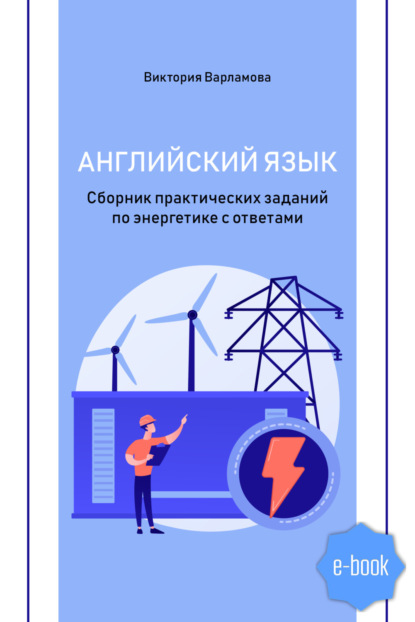По всем вопросам обращайтесь на: info@litportal.ru
(©) 2003-2024.
✖
Английский язык. Сборник практических заданий по энергетике с ответами
Настройки чтения
Размер шрифта
Высота строк
Поля
2. Kinetic energy is possessed by a _____ object by virtue of its motion.
3. Sound energy consists of moving waves of _____ in a medium such as air, water, or metal.
4. The movement of charges constitutes an _____ _____, which flows between two objects at different potentials when they are joined by a _____.
5. The splitting process is known as nuclear _____, the joining together as nuclear _____.
_____________________________________________________________________
Pressure; ability; moving; fission; fusion; conductor; electrical energy.
1.11. Дайте ответы на вопросы по теме:
1. What is energy?
2. What types of energy do you know?
3. Is kinetic energy possessed by a moving object by virtue of its motion?
4. When is radiant energy emitted?
5. What does sound energy consist of?
6. When has matter electrical energy?
7. What energy is released in chemical reactions?
8. When is nuclear energy produced?
9. What phenomenon is called the principle of conservation of energy?
10. What does the Theory of Relativity show?
1.12. Переведите предложения на русский язык письменно.
1. Physicists classify energy into several types: kinetic, potential, heat, sound, radiant energy and electrical, chemical, and nuclear energy.
2. The two principal forms of kinetic energy are known as translational (поступательная энергия) and rotational(энергия вращения).
3. An object possesses heat, or thermal energy by virtue of its temperature.
4. Radiant energy consists of electromagnetic radiation and includes radio waves, visible light, ultraviolet and infrared radiation, and X-rays.
5. Chemical energy is possessed by substances that undergo a chemical reacton, such as combustion.
6. The splitting process is known as nuclear fission, the joining together as nuclear fusion.
7. The principle of conservation of energy states that energy can neither be created nor destroyed but only converted into other forms.
8. Four properties of a wave can be distinguished and described mathematically: wavelength, frequency, velocity and amplitude.
Тема 2. Звуковая энергия
2.1. Найдите перевод терминов.
2.2. Переведите однокоренные слова:
2.3. Прочитайте и переведите текст:
Text: Sound Еnergy.
Energy may take various forms — sound, chemical, and electrical energy, for example Sound consists of waves of alternate compression and rarefaction that transmit kinetic energy through a medium. If there is no medium, there is no sound; sound waves cannot pass through a vacuum. All sounds originate from vibrating objects, such as the vocal cords in the human throat, the skin of a drum, or the strings of a violin. The vibrations are then passed on through a medium — most commonly air — until they strike the ear drum; the ear converts the vibrations into nerve impulses, which pass to the brain where they are interpreted as sounds. Microphones are the other most common instruments of sound waves into electrical signals.
Waves and sound. There are two types of waves in physics: longitudinal and transverse. Sound waves are of the longitudinal type — that is, their vibrations take place in the same direction as they travel.
Transverse waves are those in which the vibrations occur at right angles to the direction, in which the waves travel — as happens, for example, when a length of rope is moved regularly up and down to give it a wavelike appearance. Ocean waves and light waves also travel by transverse propagation.
Frequency and intensity. The frequency of a sound wave is the number of wavelengths that are completed in a given period of time. The universal unit of measurement is the hertz (Hz), which represents one complete wavelength, or cycle, per second. The human ear is sensitive to sound in the frequency range from about 20 Hz. As people grow older, their ability to perceive high frequencies diminishes.
The intensity of sound is measured in terms of the amount of power that passes each second through a given area perpendicular to the direction of the sound wave. The intensity unit is the decibel (db).
Velocity. Sound can be transmitted by any medium — gas, liquid, or solid — and all sound waves travel at a constant velocity through any given medium at a constant temperature. But depending on their elasticity and density, some mediums transmit waves faster than others.
The velocity of sound is affected by temperature; as the temperature increases, the medium expands. Its density decreases, with the result that the velocity of sound increases.
2.4. Найдите предложение, содержание которого не соответствует теме и смыслу текста.
1. A sound wave consists of a series of alternate compressions and rarefactions of the medium through which it passes.
2. Waves of alternate compression and rarefaction transmit kinetic energy through a medium.
3. As people grow older, their ability to perceive high frequencies diminishes
4. There are two types of waves in physics: longitudinal and transverse.
5. Solar energy is an alternative source of energy.
2.5. Найдите перевод словосочетаний на английский язык в тексте:
1. кожа барабана ________________________________________________
2. струны скрипки ______________________________________________
3. продольная волна ____________________________________________
4. человеческое ухо _____________________________________________
5. постоянная температура ______________________________________





